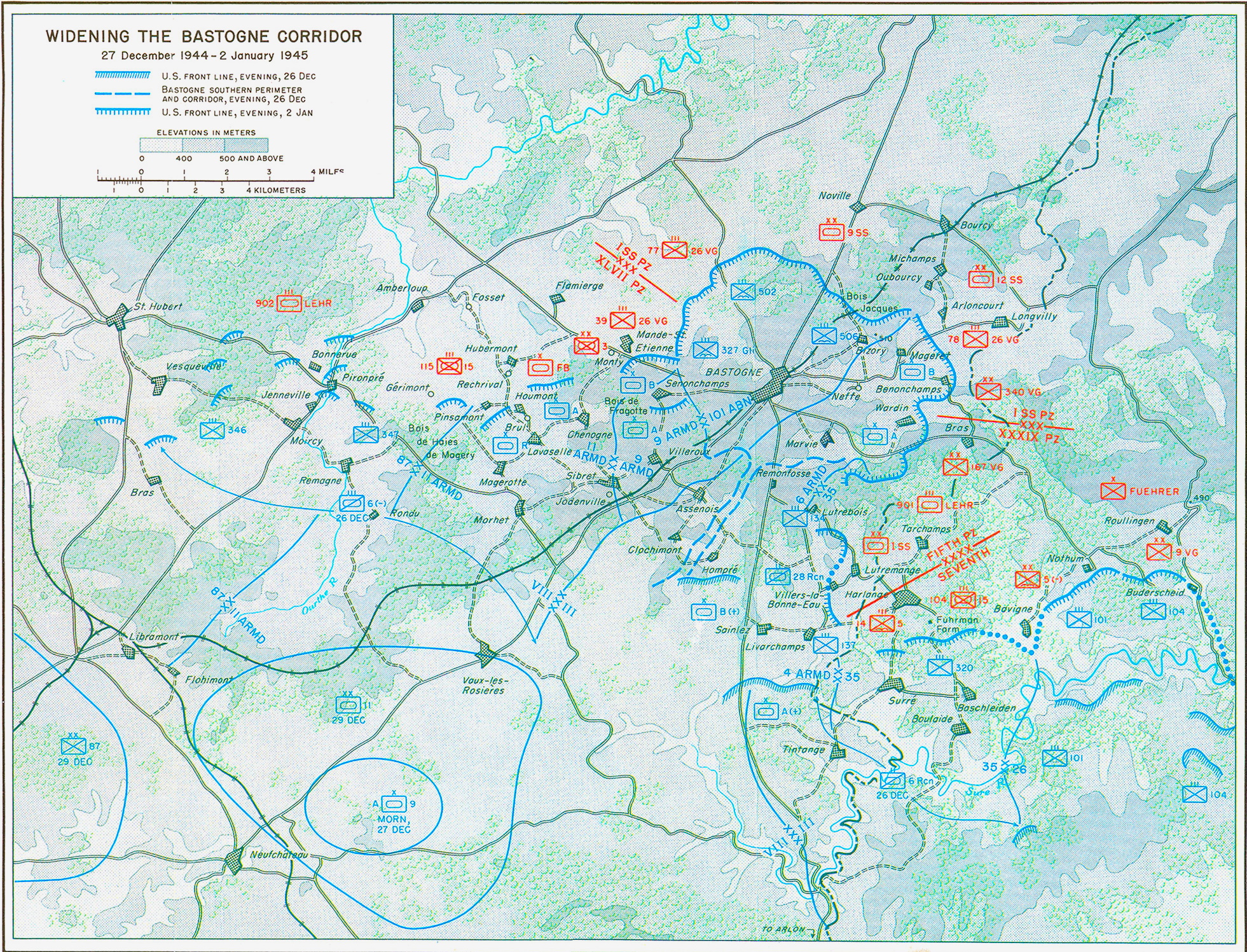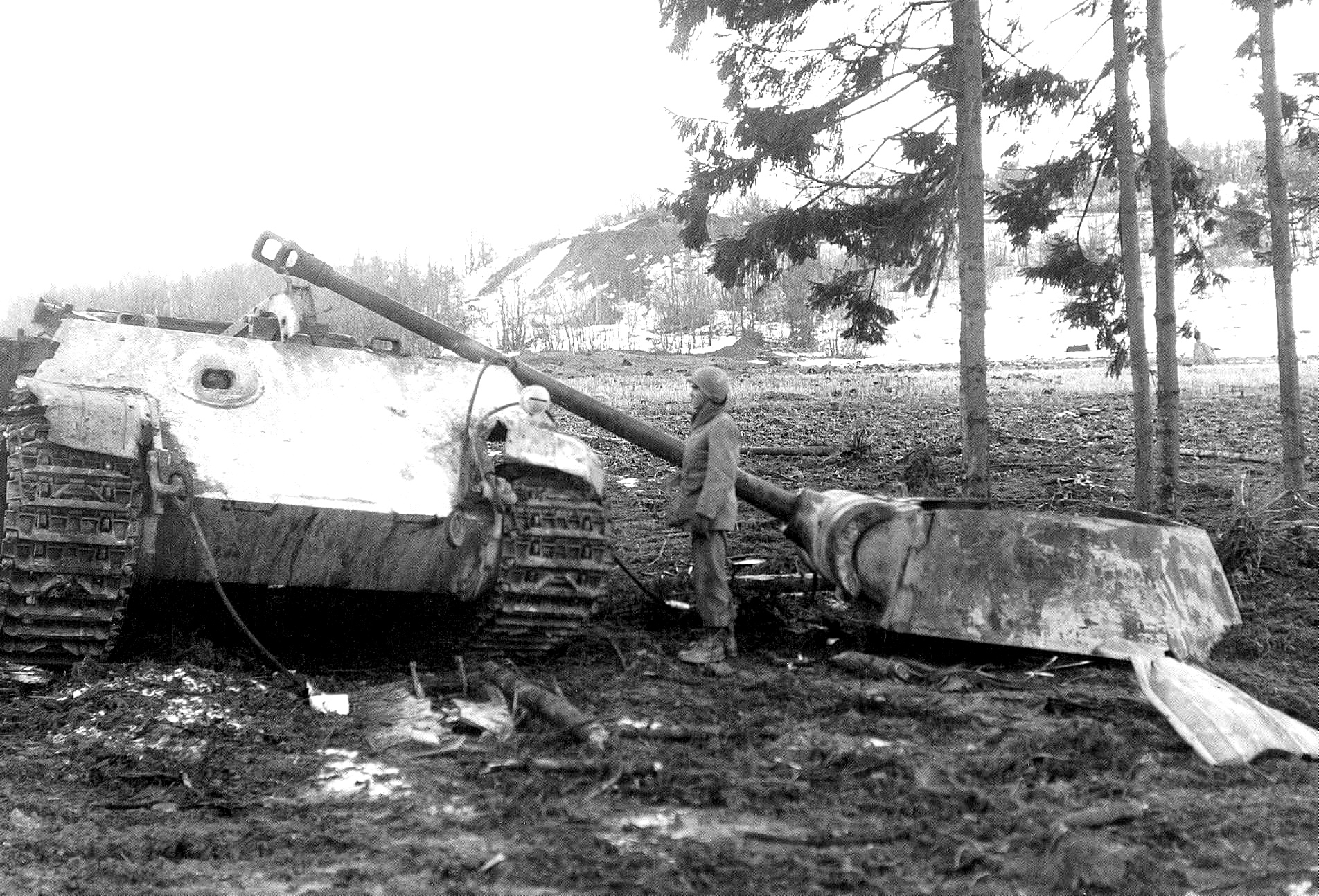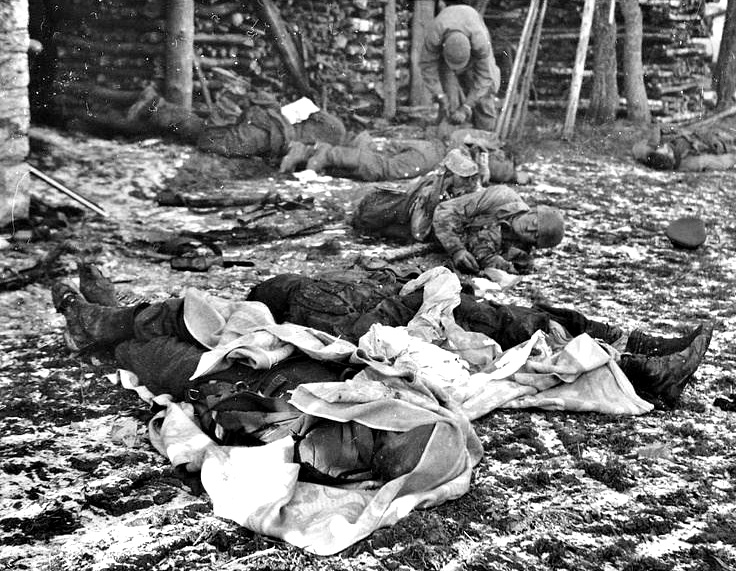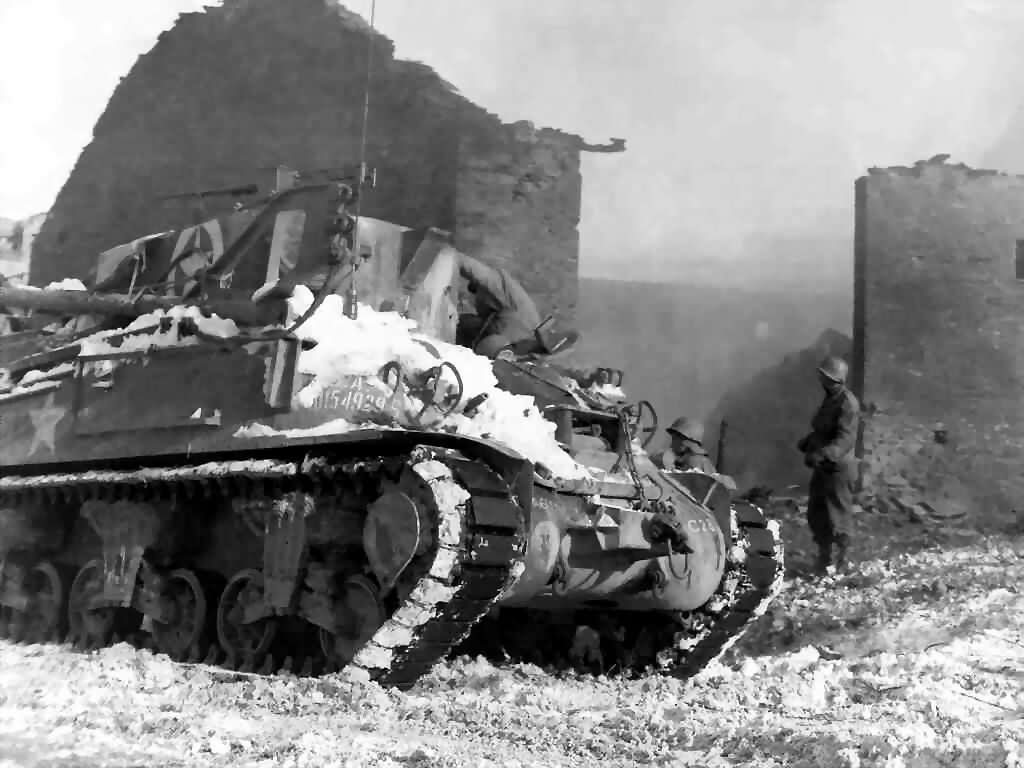The artillery battalion located southeast of Rechrival defended itself stubbornly with direct fire against attacking tanks. Three enemy tanks were thereby put out of action. The successful assault gun company and the antiaircraft guns located on the edge of the Bois de Valet enabled the formation of a strong point-like front by the III Battalion by way of the southern edge of Gérimont – Acul, the hills southeast of Rechrival, and the southern edge of the northwestern extension of the Bois de Valet. When I believed the danger point in this sector to have been cleared up, I drew back again to Chenogne. In the meantime, that locality had been turned into a pile of stones by continuous bombing attacks and concentrated artillery fire. I had just arrived in the first house when a strong enemy tank attack by way of Mande-Saint-Marie against Chenogne, with flanking pressure against the northern hollow, was carried out. Because I encountered only a few of our damaged tanks and a few grenadiers in the locality itself, which had affected a billet in the cellars in the ruins of the locality, I considered the situation extremely critical. I have paralyzed myself for quite some time, as far as commanding was concerned, because an enemy tank stopped a few meters from my house. It was nevertheless possible to send off two radio messages from the command armored personnel carrier, which was located in the dead space of the house.
These messages were sent to the armored group: locality to be held to last man and the request for support to be sent to the 3.PGD. I wondered why the enemy tanks and armored personnel carriers, which were manned by crews, did not take the locality, although they were hardly fired upon at all from the locality. As I later found out, our armored group had taken up the tank battle, standing around Chenogne in a semicircle and skilfully taking advantage of the terrain, because of the previous continuous bombing attacks on the locality, while at the same time the tanks located on the northern edge of the woods south of Chenogne, as well as the heavy antiaircraft battery located on the southern edge of the Bois de Valet, were very effective. This battle is one of the toughest that the brigade experienced during the Ardennes Offensive. The attack was repelled during the afternoon and Chenogne remained in our possession. In my opinion, the locality could have been taken by a dismounted infantry company because the locality itself was hardly occupied. Our losses of men during the day were heavy because the brigade had to organize itself for the defense from an attack position under strong enemy pressure. Nevertheless, this day led to a complete defensive success through the will to fight and the bravery of the German soldier.
This success resulted in the enemy’s losing about 30 tanks. In my opinion, the enemy attack was set too rigidly against Chenogne. It would have been no doubt that the enemy would have had more success if the point of main effort of the attack had been with the combat team advancing on Rechrival because this combat team had practically thrust through the defense of the brigade near Rechrival with its advance guard point while the bulk of the brigade was tied up in the battle around Chenogne. In addition, there was the fact that, as so often, the brigade was given time during the night to form a new defensive front without any disturbance. The oft-said sentence: Lord let the evening come, then is the battle won, proved true, even in this critical situation. The American force could have saved a lot of blood if had continued to exploit the successes of the day during the night. This and the proverbial dread of fighting in the woods were two certain factors that could be taken into account in formulating tactical measures. Both were things that astonished us Eastern-Front warriors vary greatly. The evening report of the brigade to 3.PGD expressed the fact that a repetition of the attack on Sibret could not be made with the means at our disposal, and that, on the other hand, all the forces the brigade would have to be concentrated in order to be able to hold the front in case of further enemy attacks.
December 31, 1944 (Subordinated to the XLVII Panzer Corps) During the night, the brigade was regrouped. The 3.PGD took over Chenogne. The boundary line ran about as follows: from the road crossing south of the Herbaimont Forest (Bois de Herbaimont) to the eastern edge of Renuamont and to the western edge of the Valet Forest (Bois de Valet) to Flohamont. The left boundary with the Panzer-Lehr-Division: the western edge of Lavacherie to the road fork east of Pirompré and to the outskirts of Remagne. Because all three battalions were equally exhausted from fighting and relief of the badly hit III Battalion could no longer be achieved on time, I decided to leave the front from Gérimont to Pinsamont and to Rechrival to the western tip of the Bois de Valet which was occupied only as a series of strong points, in its present grouping, despite the attack expected on the next day. The III Battalion was reinforced with about 100 men. To this end, I created for myself two strong tactical reserves with the mission of clearing up possible enemy penetrations by immediate counterthrust. For this purpose, the I battalion and the tank battalion were considered for the eastern Rechrival sector, the sector including the point of main effort, the II Battalion, and the assault gun battalion for the western sector. A heavy antiaircraft battery was committed in the patches of woods north of Renuamont for defense against enemy tanks that might break through to the north onto the main road.
The heavy antiaircraft battery committed in the area north of Sprimont (Saint-Ode) was likewise ordered into such a position that it could fire on enemy tanks that had made penetrations, in addition to its air defense. The II Battalion was to send forth continuous reconnaissance in force in the direction of Remagne and into the Bois des Haies de Magery. The Brigade command post was moved to Lavacherie and the forward command post near the armored group in Fosset. The relief in Chenogne was not ended until daylight. Enemy forces affecting a temporary penetration were turned back by tanks that were already advancing. During the course of the day, a number of attacks, which did not have the force of attacks on Rechrival and Pinsamont on the previous day, were repelled by the brave III Battalion and by concentrated artillery fire.
January 1, 1945 During the night, the II Battalion took over the sector from Gérimont to Pinsamont, together with the tactical reserve in Tillet, to which a battery of the assault gun battalion was brought up from Amberloup. Reconnaissance in force to the southeast was ordered sent out from Tillet. The III Battalion was reinforced by the company located in Pinsamont. The extremely critical motor fuel situation – during the following day, the tanks had only enough motor fuel for a distance of 15 to 20 km at times – compelled the armored vehicles to keep close together. After counter thrusts had taken place, the tanks often had to be left upfront in order not to use up motor fuel unnecessarily. All vehicles which were not combated vehicles were parked north of Ourthe. After 0900, the enemy attacked continuously with tank support. Several enemy tanks which had broken into Hubermont and Rechrival were put out of action in close combat by the men of the III Battalion. More tanks (about 8) were put out of action by the antiaircraft battery located in the patches of woods northeast of Renuâmont. In Hubermont, the commander of the III Battalion was killed in close combat.
The toughly and inexorably led the battle of this battalion, which had been facing the enemy without interruption since December 19, 1944, created favorable conditions for the participation of the armored group, which threw the enemy back into the jump-off positions. Pinsamont was lost. The company that was thrown out of that locality belonging to the II Battalion took up the fight anew on the ridge between Acul and Rechrival with its front to the southeast. A counterthrust did not take place because Pinsamont was located far out from the general course of the front. A weak attack on Gérimont was repelled. In the sector of the adjacent unit (left flank), Chenogne was lost at one o’clock. As a result, the left wing of the III Battalion was withdrawn in the evening hours to the hills south of Milliomont.
January 2, 1945 The withdrawal of the badly battered III Battalion and its relief by the I battalion was ordered for the night. The III Battalion was supposed to rest up in Amberloup in order to occupy the right sector of the brigade, the southern part of the Chenaie Forest (Bois la Chenaie), on the following morning. By doing this, I wanted to have the left sector of the brigade defended by the II Battalion, which was the most powerful. I knowingly forewent a rather strong tactical reserve commanded by the brigade in doing so. Still, I ordered all battalions to set aside at least 1/3 of their fighting strength as local reserves for immediate counterthrusts. A part of the armored group was also committed within the framework of the I Battalion in such a manner that enemy tanks could be put out of action even before reaching the main line of resistance. In order to save blood, the heavy weapons thus became the mainstay of the defensive battle. At this time, the battalion had a fighting strength of about 150 men. Generally speaking, the rifle companies were 25 to 30 men strong during the course of the day all attacks on the left were successfully repelled without the occurrence of any penetrations. Several enemy tanks were put out of action north of the Bois de Valet (Valet Forest). In the case of the II Battalion, Gérimont was lost after a second attack. A further advance to the north was averted by the participation of an assault gun company.
January 3, 1945 On January 3, no attacks worthy of mention took place. After 1000, the III Battalion was in the position ordered. During the night, the exposed elements of the II Battalion in Acul were withdrawn to Chenogne. The rumble of motors reported south of Rechrival in the night was interpreted as the preparation for an attack for the following day. (Relief of the 11th Armored Division by the 17th Airborne Division). At the evening, the brigade had about 25 tanks and assault guns ready for action, 15 in repair, and about 15 to 20 tanks which were located on our road of advance, for the most part, with mechanical damages. The bulk of them could not be towed off as yet because no motor fuel was available for that purpose.
January 4, 1945 On January 4, there was only enemy patrol activity in the right sector of the brigade. To the left, there was the successful defense against several attacks against Hubermont by means of antitank fire from the heavy antiaircraft battery located in the patches of woods northeast of Renuâmont. Taking into consideration the temporary enemy penetration in Flamierge in the case of the adjacent unit to the left, our own left flank was covered. Furthermore, an assault gun battery was temporarily given to the 3.PGD. The antiaircraft battery mentioned above, which is known to have been under continuous enemy artillery fire, changed position during the evening to the region of the southern edge of the Herbaimont Forest (Bois de Herbaimont). The Brigade command post was moved, according to orders, to Roûmont. The forward command post remained in Fosset.
January 5, 1945 On January 5, an attack was made in the right sector on the III Battalion. After all, attacks had been repelled during the day, the two companies located in the southern part of the Chenaie Forest were captured, with about 60 men, during the evening hours. Only a few machine guns bursts were heard and the position was later found empty. Apparently, these companies had been attacked from the rear. It remains enigmatic why the enemy did not march further to the north through the forest. He could have hardly met up against any resistance there. In this connection, it must be said that the enemy forces (in this case, the 87th Infantry Division) fought very skilfully, as far as infantry was concerned. It was the only force for which we had respect, even during the night. In the area of Tillet, patrols were encountered behind our lines which shouted to our post, relief detachments, in German and thereby cause so many a surprise.
January 6, 1945 During the day, a number of attacks were made on Tillet in the sector of the II Battalion. The locality was held in hard fighting. East of Tillet, the enemy was able to gain several hundred meters. The brigade forewent counterthrusts south of the road from Tillet to Lavalle, taking into consideration the enemy artillery superiority and fighter bomber attacks, which shattered every movement during the day in the open terrain. On the other hand, enemy forces that had temporarily advanced in Tillet and across the road from Tillet to Lavalle were thrown back by counterthrusts. In order to save blood, the brigade ordered the II Battalion, which was located in the open terrain, to take up reverse-slope positions if possible, in order to break up enemy attacks in front of our mainline resistance by the fire of heavy weapons from the low ground. This also had the advantage that the enemy artillery could not hit our forward lines with observed fire. The experience of the last several days had shown that the enemy did not begin his attacks, as a rule, until after a rather long artillery preparation. Then, if the attack following it ran up against resistance, it was broken off at once. Then an artillery preparation began again, followed by an infantry attack. That was repeated a number of times during the day. It was not until almost no resistance took place from the MLR that the enemy infantry went forward.
A paralysis of our heavy weapons, especially of the artillery, was hardly brought about, however, except temporarily by fighter-bombers. In view of the shortage of ammunition in our artillery, the enemy infantry was supposed to be repelled with heavy losses by a battle from a reverse-slope position with infantry and machine-gun fire commencing suddenly at the last moment. The prerequisite for such a conduct of battle is, naturally, that the heavy weapons, especially the artillery, have good possibilities for observation into the terrain ahead from commanding points in the rear terrain. Moreover, the brigade was struck by the fact, during the last several days, that the enemy attacks were led in a quite disorganized manner with respect to time and place. For the most part, the sector of only one battalion was attacked. The explanation for this fact was to be found in the statements from prisoners of war, from which it was learned that the brigade had two enemy divisions before it which were apparently not under one command.
January 7, 1945 January 7, was again a very difficult day for the brigade. Tillet and the sector Rechrival – Hubermont – Milliomont were alternately attacked. The attacks were again introduced by strong artillery and fighter-bombers attacks. All attacks on Tillet and to the east of that locality were readily repelled. Toward evening, the enemy succeeded in penetrating into Milliomont from a southeasterly direction. In Renuâmont, into which the enemy thrust immediately thereafter, a weak company – about 20 men – was assembled and sent to hold two farmhouses. Although surrounded and repeatedly attacked, it was still fighting stubbornly and bravely at 2300. The entire armored group was in combat and did have any more reserves at all. A company of about 25 men, which was quickly thrown together by the brigade, was set out during the night for the purpose of counterattacking. A detachment of the small unit, thrusting through the middle of the village, which was occupied by the enemy, succeeded in blocking off the village to the rear in an energetic night attack, while the rest of the company took one house after another, thereby relieving the company which was bravely holding out.
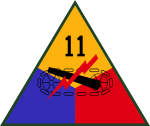
 Moreover, about 140 prisoners were brought in. Despite the fact that the unshaken young company commander lost his right hand in close combat at the beginning, he led this undertaking to full success and did not take leave from the brigade until the following morning. Apparently, this nocturnal attack must have caused very great panic, because we were able to occupy Hubermont and Milliomont again almost without a fight. Taking the contact with the adjacent unit to the left into consideration, the Army Corps permitted the MLR to be moved to a line from the southern edge of Renuâmont to Rechimont to the southern edge of the patch of woods west of Rechimont. Weak outposts were left in the line from Lavalle to Hubermont to Milliomont. This position meant a shortening of the front and had better possibilities of effect into the terrain ahead.
Moreover, about 140 prisoners were brought in. Despite the fact that the unshaken young company commander lost his right hand in close combat at the beginning, he led this undertaking to full success and did not take leave from the brigade until the following morning. Apparently, this nocturnal attack must have caused very great panic, because we were able to occupy Hubermont and Milliomont again almost without a fight. Taking the contact with the adjacent unit to the left into consideration, the Army Corps permitted the MLR to be moved to a line from the southern edge of Renuâmont to Rechimont to the southern edge of the patch of woods west of Rechimont. Weak outposts were left in the line from Lavalle to Hubermont to Milliomont. This position meant a shortening of the front and had better possibilities of effect into the terrain ahead.
January 8, 1945 On January 8, unsuccessful attacks were made on Tillet and positions east of it. In the area from Milliomont to Hubermont, only weak enemy scatting raids. A heavy antiaircraft battery went into position north of Ourthe to support the artillery battalion, which was suffering from a lack of ammunition.
January 9, 1945 On January 9, there were no attacks in the sector of the I and II Battalions. In the case of the III Battalion, the situation demanded a withdrawal of the front line to the road to Tillet. During the night, the fighting strength of the rifle companies was brought up to 30 men, and those of the heavy weapons companies to 80 men. Brigade found out that a withdrawal of the front was planned. The following lines were reconnoitered and, according to orders, were improved by supply personnel that moved up: (1) Tonny to the southern edge of Amberloup to Fosset and toward Macravivier, and (2) The hill northeast of the Rau de Laval sector to the road fork located at the southern tip of the Herbaimont Forest (Bois de Herbaimont).
January 10, 1945 Renewed attack on Tillet. During the evening, the locality was lost after a tough battle. In view of the withdrawal planned, no counter-attack was ordered. No attacks at all in the other sectors.
January 11, 1945 No special happenings. During the night, the brigade disengaged itself from the enemy without interference and reached the area around Wembay – Cens – Berguème. The I battalion occupied the line from east of Lavacherie to Aviscourt to the road fork south of the Bois de Herbaimont with a few tanks. During the night of January 11/12 1945, the brigade was released from the XLVII Panzer Korps and became an Army Reserve.
/s/ Generalmajor Otto Remer
This study on the Ardennes Operations of the Fuehrer Escort Brigade by Generalmajor Remer is the continuation and conclusion of MS # B-592. The present work describes the last commitment of the Fuehrer Escort Brigade in the Western Theater, on the left wing of the 5.Panzer-Army, before its transfer to the East near the end of January 1945. This commitment occurred during the retreat of the 5.Panzer-Army from the Bastogne area toward the West Wall, and was intended to facilitate a withdrawal of our hard-struggling units. Events at a higher level are described in MS # B-322 (LVIII Panzer Corps). The second section of the study furnishes the answers to a number of questions asked of Generalmajor Remer in Allendorf.
/s/ General der Panzertruppe Erich Brandenberger
Ernst Otto Remer joined the Army as an officer candidate in 1933 and was assigned to the 4.Regiment at Kolberg as a 2/Lt of infantry in 1935; in 1938 he was promoted 1/Lt and placed in command of a company of the same regiment. In the 1939 Poland Campaign Remer commanded the infantry howitzer company of the 478.Regiment; in 1940, the Campaign in France and the Balkan Campaign of 1941 he was in command of the motorized infantry howitzer company of the 701.Regiment. In 1941 he was promoted Capt and in February 1942 was assigned as acting commander of a battalion in Russia. Later in 1942, he was given command of an armored infantry battalion of Panzer-Grenadier-Regiment Grossdeutschland, an elite unit from which Panzer-Division-Grossdeutschland was formed in May of the same year. Promoted Maj in January 1943, Remer was transferred as a battalion commander to Guard-Regiment-Grossdeutschland in Berlin in May 1944. It was while serving in this assignment that he played a major role in putting down the uprising which followed the attempted assassination of Hitler on July 20, 1944. In recognition of his action on this occasion, Remer was promoted Colonel, dated July 1, 1944, and assigned as Combat Commander Rastenburg on September 1, 1944. Three months later he was placed in command of the Hitler Escort Brigade, with which he took part in the Ardennes Offensive. In February 1945, he was promoted to Maj Gen and transferred to the Eastern Front together with his brigade, which at the same time was upgraded to the status of a panzer division. On May 22, 1945, the general was taken into custody by US forces at Bamberg, Bavaria.
January 13, 1945 During the night of January 12, the Fuehrer Escort Brigade marched through Ortho, Nisramont, Filly, Nadrin, Wibrin, Houffalize, Tavigny in Belgium then Troine, Wincrange, Boevange, Doennange, Deiffelt in Luxembourg. The bulk of the brigade arrived about noon of the next day. The brigade was subordinated to the XXXIX Corps as an army reserve. Its command post was in Deiffelt. The flak regiment was immediately employed in the assembly area for air defense. During the late afternoon a combat team consisting of the 1.Battalion, assault gun battalion, and artillery battalion advanced to Moinet, Belgium, to take part in a counterattack southeastward from Michamps. The team was to assist the heavily decimated 167.VGD under Oberst Theodor Tolsdorff. (Note: The Order of Battle of the Germany Army indicates Gen Hans-Kurt Hoecker commanded the 167.VGD at that time, and Col Tolsdorff the 340.VGD. The CP of the 167.Division was also in Moinet.
Beginning at dawn, the attack was to lead from Michamps through Oubourcy in Belgium, clear the forest patches 1½ km southwest of Oubourcy, and restore the old main line of the division. At the same time, the 9.PD was to attack on the right of the combat team, north of the railroad line, from the Oubourcy area. During the night, the battalion along with the artillery of the 167.VGD, was to support the attack. It was planned to carry the attack, on horseback if possible, at least as far as the patches of forest southwest of Oubourcy during the dawn hours. After reaching the old main line the 167.VGD was to take over its sector again. After a conference with the division commander, it was learned that the contemplated infantry support by the 167.VGD could hardly be expected, for the division at that time had a trench strength of only a few dozen men. Preparations were made for a surprise, lightning-like attack without preliminary artillery fire. If possible, the old line was to be reached before the ruinous enemy artillery fire could set in. Necessary recon had to be carried out during the night. Repeated requests for the 9.PD to begin its advance simultaneously with the combat team was granted by the corps. The assembly was completed without casualties under harassing enemy fire. Our own harassing fire was intended to conceal the noise of our armored vehicles being driven into the assembly positions.














